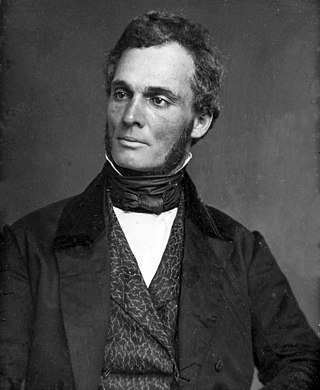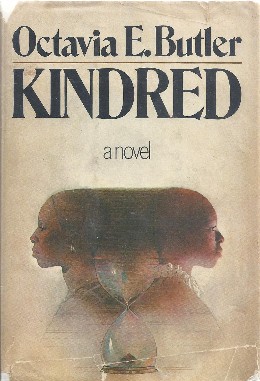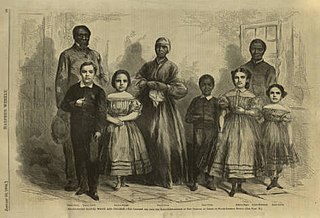
Uncle Tom's Cabin; or, Life Among the Lowly is an anti-slavery novel by American author Harriet Beecher Stowe. Published in two volumes in 1852, the novel had a profound effect on attitudes toward African Americans and slavery in the U.S., and is said to have "helped lay the groundwork for the [American] Civil War".

Harriet Jacobs was an African-American abolitionist and writer whose autobiography, Incidents in the Life of a Slave Girl, published in 1861 under the pseudonym Linda Brent, is now considered an "American classic".

Robert Purvis was an American abolitionist in the United States. He was born in Charleston, South Carolina, and was likely educated at Amherst Academy, a secondary school in Amherst, Massachusetts. He spent most of his life in Philadelphia, Pennsylvania. In 1833 he helped found the American Anti-Slavery Society and the Library Company of Colored People. From 1845 to 1850 he served as president of the Pennsylvania Anti-Slavery Society and also traveled to Britain to gain support for the movement.

William Still was an African-American abolitionist based in Philadelphia, Pennsylvania. He was a conductor of the Underground Railroad and was responsible for aiding and assisting at least 649 slaves to freedom towards North. Still was also a businessman, writer, historian and civil rights activist. Before the American Civil War, Still was chairman of the Vigilance Committee of the Pennsylvania Anti-Slavery Society, named the Vigilant Association of Philadelphia. He directly aided fugitive slaves and also kept records of the people served in order to help families reunite.

Frances Ellen Watkins Harper was an American abolitionist, suffragist, poet, temperance activist, teacher, public speaker, and writer. Beginning in 1845, she was one of the first African American women to be published in the United States.

Incidents in the Life of a Slave Girl, written by herself is an autobiography by Harriet Jacobs, a mother and fugitive slave, published in 1861 by L. Maria Child, who edited the book for its author. Jacobs used the pseudonym Linda Brent. The book documents Jacobs's life as a slave and how she gained freedom for herself and for her children. Jacobs contributed to the genre of slave narrative by using the techniques of sentimental novels "to address race and gender issues." She explores the struggles and sexual abuse that female slaves faced as well as their efforts to practice motherhood and protect their children when their children might be sold away.

Harriet E. Wilson was an African-American novelist. She was the first African American to publish a novel in North America.
African American literature is the body of literature produced in the United States by writers of African descent. It begins with the works of such late 18th-century writers as Phillis Wheatley. Before the high point of enslaved people narratives, African American literature was dominated by autobiographical spiritual narratives. The genre known as slave narratives in the 19th century were accounts by people who had generally escaped from slavery, about their journeys to freedom and ways they claimed their lives. The Harlem Renaissance of the 1920s was a great period of flowering in literature and the arts, influenced both by writers who came North in the Great Migration and those who were immigrants from Jamaica and other Caribbean islands. African American writers have been recognized by the highest awards, including the Nobel Prize given to Toni Morrison in 1993. Among the themes and issues explored in this literature are the role of African Americans within the larger American society, African American culture, racism, slavery, and social equality. African-American writing has tended to incorporate oral forms, such as spirituals, sermons, gospel music, blues, or rap.

Clotel; or, The President's Daughter: A Narrative of Slave Life in the United States is an 1853 novel by United States author and playwright William Wells Brown about Clotel and her sister, fictional slave daughters of Thomas Jefferson. Brown, who escaped from slavery in 1834 at the age of 20, published the book in London. He was staying after a lecture tour to evade possible recapture due to the 1850 Fugitive Slave Act. Set in the early nineteenth century, it is considered the first novel published by an African American and is set in the United States. Three additional versions were published through 1867.
The tragic mulatto is a stereotypical fictional character that appeared in American literature during the 19th and 20th centuries, starting in 1837. The "tragic mulatto" is a stereotypical mixed-race person, who is assumed to be depressed, or even suicidal, because they fail to completely fit into the "white world" or the "black world". As such, the "tragic mulatto" is depicted as the victim of the society that is divided by race, where there is no place for one who is neither completely "black" nor "white".

Kindred (1979) is a novel by American writer Octavia E. Butler that incorporates time travel and is modeled on slave narratives. Widely popular, it has frequently been chosen as a text by community-wide reading programs and book organizations, and for high school and college courses.

The Bondwoman's Narrative is a novel by Hannah Crafts who claimed to have escaped from slavery in North Carolina. The manuscript was not authenticated and properly published until 2002. Some scholars believe that the novel was written between 1853 and 1861. It is one of the very first books by an African-American woman, others including the novel Our Nig by Harriet Wilson, published in 1859, and the autobiography Incidents in the Life of a Slave Girl by Harriet Jacobs, published in 1861.
Hinds v. Brazealle (1838) was a freedom suit decided by the Supreme Court of Mississippi, which denied the legality in Mississippi of deeds of manumission executed by Elisha Brazealle, a Mississippi resident, in Ohio to free a slave woman and their son. Hinds ruled that Brazealle was trying to evade Mississippi law against manumissions except when authorized by the state legislature, and the actions were invalid. Both the mother and son were declared legally still slaves in Mississippi, and the son was prohibited from inheriting his father's estate, as Brazealle had left it all to him.

Our Nig: Sketches from the Life of a Free Black is an autobiographical novel by Harriet E. Wilson. First published in 1859, it was rediscovered in 1981 by Henry Louis Gates Jr. and was subsequently reissued with an introduction by Gates. Our Nig has since been republished in several other editions. It was long considered the first novel published by an African-American woman in North America, though that record is now contested by another manuscript found by Gates, The Bondwoman's Narrative, which may have been written a few years earlier.

The treatment of slaves in the United States often included sexual abuse and rape, the denial of education, and punishments like whippings. Families were often split up by the sale of one or more members, usually never to see or hear of each other again.

White slave propaganda was a kind of publicity, especially photograph and woodcuts, and also novels, articles, and popular lectures, about slaves who were biracial or white in appearance. Their examples were used during and prior to the American Civil War to further the abolitionist cause and to raise money for the education of former slaves.

Harriet Forten Purvis was an African-American abolitionist and first generation suffragist. With her mother and sisters, she formed the first biracial women's abolitionist group, the Philadelphia Female Anti-Slavery Society. She hosted anti-slavery events at her home and with her husband Robert Purvis ran an Underground Railroad station. Robert and Harriet also founded the Gilbert Lyceum. She fought against segregation and for the right for blacks to vote after the Civil War.
Poems on Miscellaneous Subjects is a poetry collection written by Frances Ellen Watkins Harper in 1854. Her non-fiction collection of poems and essays consists of a brief preface followed by a collection of poems and three short writings. Poems on Miscellaneous Subjects sold approximately 12,000 copies in its first four years in print and was reprinted at least twenty times during Harper's lifetime. The work includes several poetic responses to Harriet Beecher Stowe's Uncle Tom's Cabin. Harper's work focuses on the themes Christianity, slavery, and women.

"The Quadroons" is a short story written by American writer Lydia Maria Child (1802-1880) and published in The Liberty Bell in 1842. The influential short story depicts the life and death of a mixed-race woman and her daughter in early nineteenth century America, a slave-owning society.

John S. Jacobs was an African-American author and abolitionist. After escaping from slavery he published his autobiography entitled A True Tale of Slavery in the four consecutive editions of the London weekly The Leisure Hour in February 1861. He also features prominently in the classic Incidents in the Life of a Slave Girl, authored by his sister Harriet Jacobs.

















